Archived Storm Damage Blog Posts
What Is Your Emergency Disaster Plan?
12/5/2022 (Permalink)
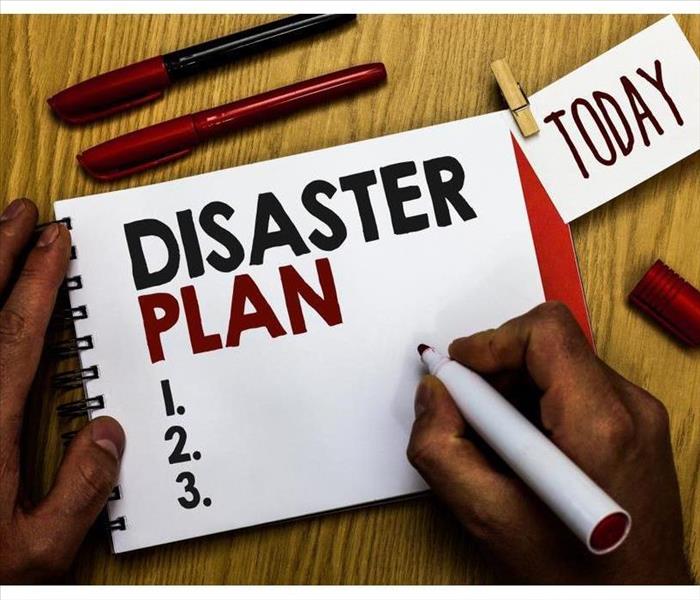 It is important to create an Emergency Disaster Plan
It is important to create an Emergency Disaster Plan
What Emergency Disaster Plan Do You Have?
Every business has a responsibility to its employees and customers to have an emergency plan in place. This can be as simple as having a fire extinguisher and first aid kit in the office or as complicated as a detailed plan that covers everything from evacuation routes, employee communication, and more. The reason for this is simple: the more prepared you are for emergencies, the less likely they are to happen in the first place!
Identify Hazards
The first step to creating your Emergency Disaster Plan is to identify all possible hazards that can occur on your property. These include, but are not limited to:
- Fire, smoke and/or soot damage
- Storm events
- Water leaks or flooding
- Bacteria or mold growth (from floodwaters, sewage backup or other water sources)
- Wet or damp items that can attract insects and pests.
Plan for Business Continuity
When you are planning for business continuity, it's important to identify key functions that must operate during and after an emergency. Determine the critical assets that will be needed to support these key functions.
Identify multiple alternate business sites where your company can relocate if a facility becomes inaccessible or unusable due to damage or other disruption. Identify primary, secondary and tertiary locations based on their proximity to your customers and suppliers as well as their ability to provide the necessary services and products.
Identify alternate communications networks so you can continue communicating with customers during an emergency. Also consider using alternative modes of communication such as email, text messaging systems or social media postings in lieu of telephone calls if possible.
Document Your Plan
Keep a copy of your emergency disaster plan in a safe place, such as a locked filing cabinet, safe, or in the cloud online. You should also make sure that all employees have read and understand the plan. If you have an employee handbook, include information about the plan in it.
For each employee on your staff, include their name and contact information on a list of people to call in case of an emergency. This will ensure that you can reach anyone who needs help quickly during an emergency.
Make sure to update this list whenever someone is added or removed from the company’s roster; this includes when new employees start working at your business and when others leave.
Implement Your Plan
- Have a backup plan in place.
- Be prepared to communicate with employees, customers, vendors and the media.
Employees should be well-informed about potential disasters
It’s important that all employees know about the emergency plan, both in order to follow it, and in order for them to be prepared for any situation. Before a disaster strikes, your employees should be familiar with where they are supposed to go in an emergency, what steps they need to take, and who they should contact if there is no one else available by phone. They should also rehearse their role in the plan so that when an actual emergency occurs, there won’t be any confusion about what needs to happen next. If there is no time for training or rehearsal during an actual emergency (or if some people miss key training sessions), remember that most people will instinctively do whatever they can while waiting for instructions from those with higher authority.
In addition to knowing the general procedures of your company's response plan (e.g., evacuating), employees should know how best way contact 9-1-1 or other emergency services if necessary.
An emergency disaster plan is a valuable asset for any business. It can help ensure that your company stays afloat in times of trouble, and it will give you a clear picture of what needs to be done in case disaster strikes. Having such a plan in place is also key to keeping employees safe and well-informed about potential dangers.
3 Things You Should Know About Flood Water
8/27/2022 (Permalink)
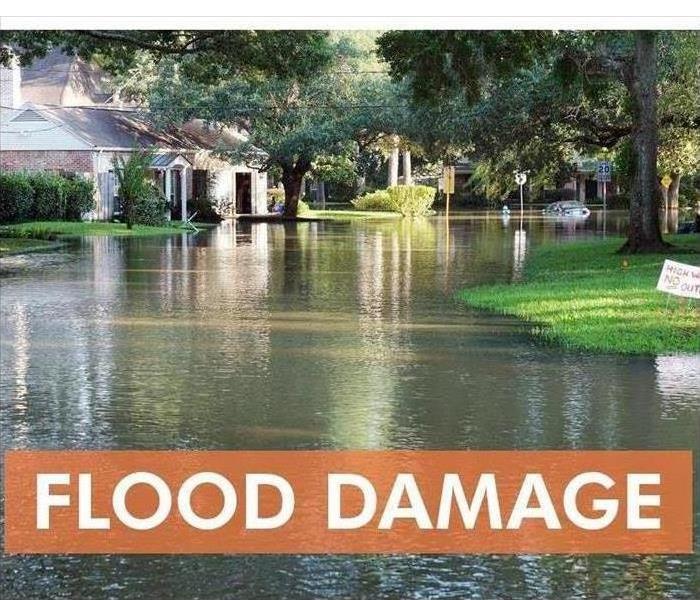 Flood water in a residential area in Deer Park, OH
Flood water in a residential area in Deer Park, OH
Three Things To Remember About Flood Water
If your Deer Park, OH, home has experienced water damage from a storm or flooding you may be wondering how to go about cleanup and repairs. However, there are a few things you should understand about the water in your home to help ensure that the restoration process is done correctly. Here are three things to remember about flood water.
1. It’s Categorized as Black Water
It’s important to note that any storm caused flooding is categorized as black water. It’s is due to the fact that it’s impossible to know where exactly this water has been, and there’s a risk it could have come in contact with sewage material. This means that there are a number of safety standards that should be met during the restoration process to ensure that your home isn’t contaminated by bacteria.
2. A Professional Should Be Called
When dealing with damage from storm flooding it’s important to follow safety procedures to avoid contamination. For this reason, it’s highly recommended to contact a local water damage restoration service to help with clean up and repairs. These professionals can not only remove the water and restore you home but can offer a variety of cleaning services as well to help ensure that any possible bacteria carried by the flood water are removed.
3. The Affected Area Will Need To Be Cleaned
Because Flood water is potentially contaminated, the affected area will need to be properly cleaned and sanitized. This is another thing a restoration service can help you with. It’s important to remember that any items in the flooded rooms will need to be cleaned as well.
It’s important to remember that storm flooding is classified as black water. This means that and water damage should be cleaned up by a professional restoration service to help ensure that the affected area is properly cleaned and sanitized. If you have any questions these professionals should be able to help.
Four Steps of the Storm Restoration Process
7/15/2022 (Permalink)
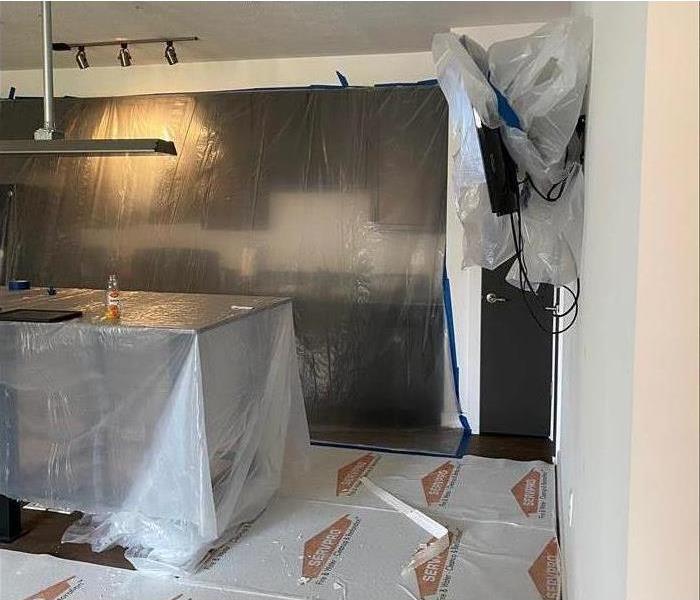 Storm cleanup in Amberly Village, OH.
Storm cleanup in Amberly Village, OH.
Storm Restoration Process
Storm season in Indian Hill, OH, often leaves a lot of home damage in its wake. Storm restoration specialists have to tear out damaged materials and rebuild your home to get it back to normal. Here is an overview of what that process entails.
1. Extract Water
The first thing technicians will do after they assess the water damage to your home is removed as much water as possible. Using industrial pumps, they remove standing water. Other methods may be used to extract water from surfaces or out of tight spaces.
2. Remove Damaged Materials
When the water is gone, experts have a better view of what else needs to go. They tear out ruined walls, insulation, carpet, tiles and other items. While some of your belongings may be able to be saved, others will likely need to be thrown out and replaced.
3. Dry Remaining Structure
At this point, it is likely that the humidity in the air has left some residual moisture which has to be remedied to prevent secondary damage. Technicians dry the remaining structure and take measures to bring humidity levels back to normal. They also disinfect the affected area to remove any bacteria left by the contaminated floodwaters.
4. Restore Home
The final stage of storm restoration is rebuilding the parts of your house that we're unable to be salvaged. New walls are put up, new flooring is installed and new tiles are laid. Then they match paint, wallpaper, and flooring to ensure that no one can tell where the damage occurred. The job isn't finished until your home looks "Like it never even happened."
If you need your home restored after a flooding event, make sure you call a restoration company quickly. The team will tear out damaged materials, dry the remaining structure, and rebuild your home so that you can return to life as normal.
How To Prepare Your Building For a Storm
4/25/2022 (Permalink)
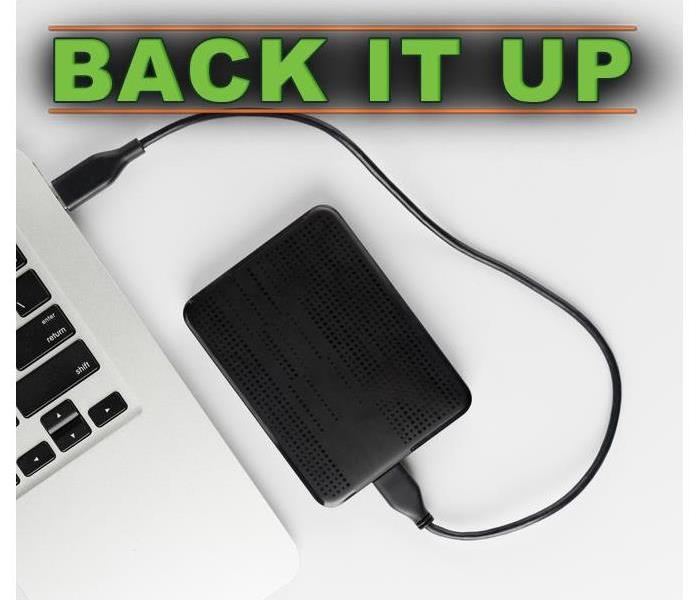 Back up digital information on a hard drive.
Back up digital information on a hard drive.
Prepare Your Building For a Storm
Many are aptly prepared for storm damage, such as flood water, in their homes, but it's equally important to prepare your commercial building if you know a storm is approaching in Indian Hill, OH. Whether you are an employee or own the building, you should help prepare your commercial building for a storm. There are many preparation tips you can keep in mind before a storm.
Assess Your Property Beforehand
To begin your storm preparation plan, it's important to assess your commercial building. You should take note of the strengths and weaknesses of where your building is located and how a storm would affect your property. Reinforce anything that would be damaged by a storm or flood water. A few ideas for your inspection include:
- Ensuring shutters are on windows in case of high wind
- Anchoring any large furniture to its place
- Removing any large branches or trees that are close to your building and could fall on it during a storm
- Making sure you've had a recent roof inspection to ensure it is strong enough to withstand a storm
Although an assessment may not seem necessary, it is important to do it before a storm comes. It's always better to be safe than be sorry.
Put Documents in a Safe Place
No matter what type of business you have, there are almost certainly important documents that need to be kept safe and dry. If you have a flooded building, documents can quickly be ruined beyond repair. Documents to preserve include legal documents, financial documents such as account statements and tax information.
Move all documents to a safe and dry space, such as an upper-level floor in a filing cabinet or back up digital information on a hard drive. Any backed-up data should be kept off-site to ensure it is kept safe.
Preparing your building for storm or water damage can prevent costly repairs from wind or flood water. If your building does experience storm damage, be sure to call in a storm damage company to help you with the restoration process.
3 Tips for Cleaning Your Store Inventory After a Flood
4/16/2022 (Permalink)
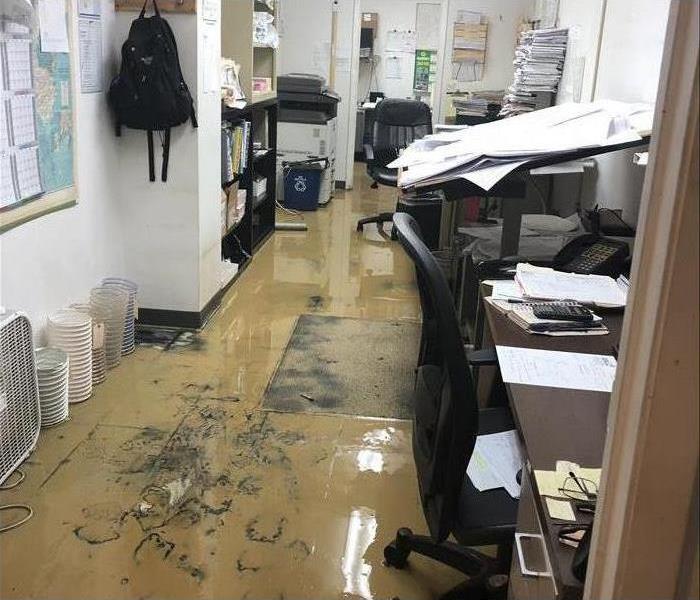 Flooded office from a storm in Cincinnati, OH.
Flooded office from a storm in Cincinnati, OH.
Tips for Cleaning Up Your Store's Inventory
When violent storms in Cincinnati, OH, affect your business and cause flooding, your inventory could suffer such serious damage that you may not know where to begin with cleanup efforts. Knowing which items might be salvaged for content cleaning and which must be thrown away can be a confusing process, but there are a few tips you can keep in mind as you sort through your items.
1. Porous Items Are Not Usually Salvageable
When floods occur during a storm, the water source is likely either runoff from overflowing nearby rivers or creeks or from backed-up sewage drains that are heavily taxed by torrential rain. In either case, the water is likely contaminated with chemicals and human and animal waste and is known as black water because of its source. As such, you may not be able to salvage porous items because of the danger of contamination, including:
- Many plastics
- Drywall
- Clothing
If you are unsure about any item you wish to salvage, you can ask your local flood restoration service whether it is porous and may retain contaminated floodwater.
2. Make a List of Salvaged Items
As you clean up after a flood, you may want to track your salvaged items and keep a list of those you want to save. While paper items are porous, storm damage and flood restoration service may be able to help you rescue important documents by freezing and decontaminating them. This type of content cleaning may help you avoid losing customer data, employee records and other vital information.
3. Set Aside Electronic Devices
Your store's electronic items such as cash registers, credit card machines, and computers may suffer considerably during flooding. However, depending on the degree of water damage, you may be able to salvage and repair them to lower any insurance claim deductibles. Avoid throwing away any electronics until you speak to a professional content cleaning service.
When major storms strike Cincinnati, OH, they can cause flooding that may affect your business. Keeping the above tips in mind as you begin the cleanup process may help you feel more confident about the outcome.
What Every Homeowner Needs to Know About Home Insurance and Sewer Backups
1/10/2022 (Permalink)
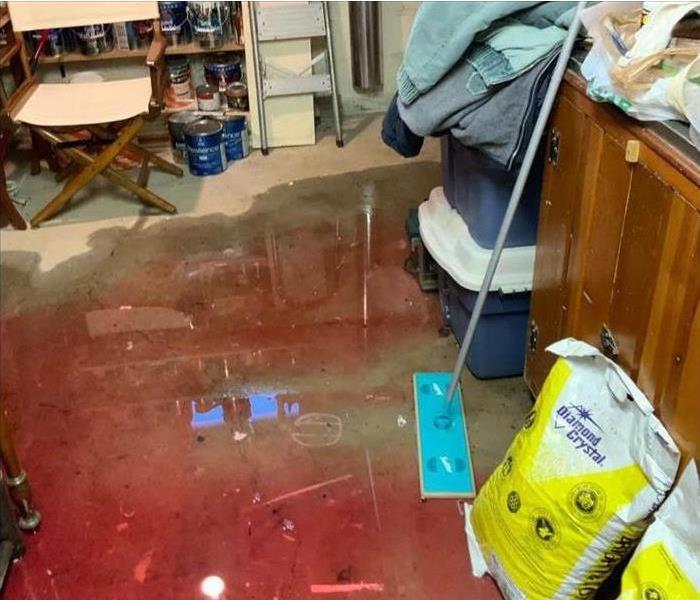 A sewer backup often strikes unexpectedly.
A sewer backup often strikes unexpectedly.
What Every Homeowner Should Know About Sewer Backups and Home Insurance
A sewer backup can be an extremely messy problem for any homeowner in Indian Hill, OH. To further complicate the situation, your home insurance policy may not cover cleanup and restoration costs, forcing you to fund repairs out-of-pocket. Carefully reviewing your current coverage may spare you considerable frustration in the long run.
A Costly Problem
A sewage overflow inside your basement or bathroom is highly unsanitary and can cause significant destruction. Depending on the specific cause of the backup and the extent of the damage, you may face numerous cleanup and repair requirements, such as the following:
- Disinfecting the contaminated area
- Removing saturated drywall and insulation
- Repairing broken sewage lines
- Replacing destroyed personal property
Without adequate home insurance coverage, these expenses can quickly mount and become extremely costly.
Potential Causes
A sewer backup often strikes unexpectedly. If your community’s storm water and sewer lines converge, your home may be particularly vulnerable, particularly if the area becomes inundated with rainwater that overwhelms the system.
If you are fortunate, you may notice subtle symptoms of a plumbing issue that may cause a sewage backup. Examples of specific signs include consistently slow-flowing drains and a lingering sewer gas odor. If you experience either situation, you may have a clogged or damaged pipe. Contacting a licensed plumber may allow you to resolve the potential issue early, sparing you from a messy sewage cleanup.
Safeguarding Your Home
You can minimize your risk of clogged or broken sewage lines by planting trees and shrubs away from pipes and throwing diapers, feminine hygiene products, wipes and paper towels in the trash instead of your toilet. Installing a back-flow valve can also prevent sewage backups.
However, possibly the most efficient way to safeguard both your home and financial security is to update your home insurance policy to ensure you are adequately covered against a sewer backup. Insurance can be a valuable financial safety net, but insufficient coverage can be extremely costly. If disaster strikes, having both your insurance company and a professional cleanup and restoration team on your side can make all the difference.
Can Employees Work During Flood Cleanup?
11/9/2021 (Permalink)
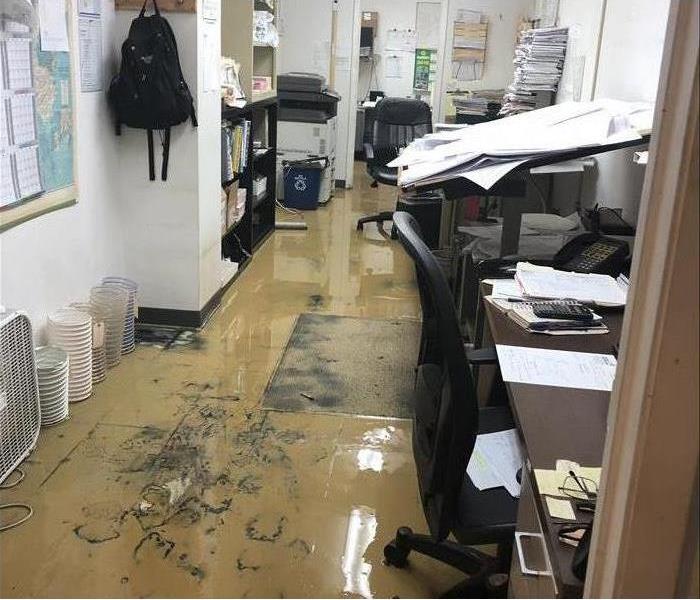 Business flood in Amberly Village, OH.
Business flood in Amberly Village, OH.
When Can Employees Return After a Flood?
Few things can bring an Amberly Village, OH, business to its knees faster than a flood. If your business has sustained water damage, your first thought is apt to be about flood cleanup. After all, accumulated black water is both unsanitary and hazardous to equipment and inventory. Once you have scheduled cleanup, though, you may wonder how soon your employees can return to work.
Beginning the Cleanup Process
Your first priority is to locate the source of the flooding. When you have fixed broken pipes or removed excess water, you must focus on water cleanup. Collaborating with a reputable restoration service is usually your best bet. Specialists have the knowledge, skill, and equipment to effectively remediate water damage.
Inviting Employees Back to Work
If your business is like most, it only functions when employees are hard at work. Of course, since black water can be dangerous, you don’t want to have employees on the job when water is present. Generally, though, you can invite your staff to return to work during the restoration process. Simply make sure all of the following are true:
- The source of the flooding has been resolved
- Flood waters have receded
- All demolition is complete
- Restoration specialists have disinfected the job site
Breathing Filtered Air
Your employees are likely to be concerned about air quality in your post-flood workplace. That makes sense, as no one wants to breath dank air. Fortunately, restoration specialists use air-filtration devices throughout the cleanup and restoration process. The result is clean, breathable air that poses little risk to employees. You may want to inform workers about the filtration system to help ease their concerns.
Business flooding in Amberly Village, OH, is not something any business owner can take lightly. Still, you don’t have to ask your workers to stay away for long. By working with the right restoration service, you can develop a reasonable timetable for employees to return to work after black water has been removed.
7 Flood Safety Tips To Be Evacuation Ready
9/18/2021 (Permalink)
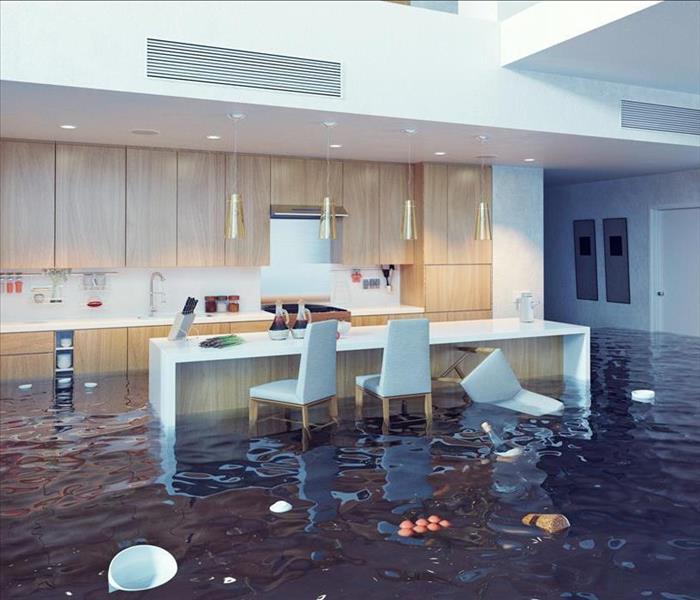 Flood safety includes returning home to Cincinnati, OH, only after the floodwaters recede and local authorities determine it is safe.
Flood safety includes returning home to Cincinnati, OH, only after the floodwaters recede and local authorities determine it is safe.
When you learn of flood warnings in your area, you must be ready to leave quickly. Your chance of successfully evacuating depends on being properly prepared. Here are 7 safety tips to get you evacuation ready for a flood disaster:
1. Know the flood risk in your area. Check flood maps for your property’s risk. Also, note the topography of the surrounding area. Where are rivers, creeks, high areas, and low areas?
2. Know evacuation routes and alternatives. Check local authorities for existing routes. Increase your flood safety by anticipating areas that may be impassible such as small creeks that could channel larger amounts of water, low areas, and bridges.
3. Know your destination. Have enough supplies to reach your destination and make sure your family knows where to find you.
4. Keep your car filled with gas. You won’t have time to wait in line at a gas station when evacuating, or worse, risk not getting gas due to a shortage from demand in the local area.
5. Keep emergency cash ready. ATMs will have long lines and quickly run out of cash.
6. Keep a “go bag” so you can leave fast. Having some personal items as well as non-perishable food, water, and medications in a bag is a great way to prepare for a fast departure.
7. Make a communication plan. Remember that communications can be disrupted during disasters and flood safety includes having a plan for this. Designating a distant friend as a point of contact for your family is best.
Flood safety includes returning home to Cincinnati, OH, only after the floodwaters recede and local authorities determine it is safe. Do not drive through floodwaters and do not go around police barricades, which are there for your safety. You will have a big job ahead of you with cleanup, but a professional remediation company can guide you through the process.
3 Flood Safety Tips
8/4/2021 (Permalink)
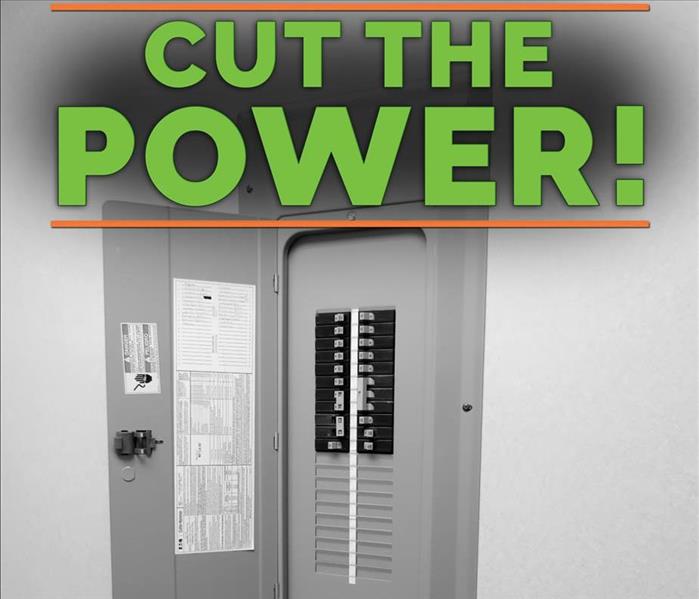 Shut off the power right away.
Shut off the power right away.
Flood Safety Steps
If your Cincinnati, OH, home has experienced a flood, the first thing on your mind will be how to get the conditions back to normal. Before the cleanup and restoration process begins, however, you should take steps to make sure everything is done safely. Read on to learn some flood safety steps for the cleanup process.
1. Turn Off Electricity
The first thing you should do is turn off all power in the flooded areas. If you can reach your breaker without walking through standing water, shut off the power right away. If you can’t reach the breaker without walking through standing water, call an electrician to help you.
2. Remove Water
Mold can pose a flood safety issue, so the next thing to do is to get rid of as much water as possible. Open windows and doors to let the building air out. Use a dehumidifier and fan to speed up the process. Remove any rugs from the area and put them outside to dry.
3. Clean Up
Wear gloves, a face mask and boots for the cleanup process in order to reduce exposure to chemicals or toxins. Dispose of any damaged items including papers, wall coverings and carpeting. These items typically don’t last through significant flooding, but hard surfaces and clothes can often be cleaned.
An expert will have more knowledge about the best products to use to reduce the risk of mold or mildew, so it may be wise to contact a remediation expert in your area. In addition to knowledge, experts have access to tools, technology and additional safety tips.
Flooding from a storm is an unfortunate situation for any homeowner, but there are some flood safety steps you can take to move forward quickly. Turning off the power, airing out the area and cleaning up the immediate damage are all-important first steps to getting your home back to normal.
What Should a Business Do During a Thunderstorm?
5/19/2021 (Permalink)
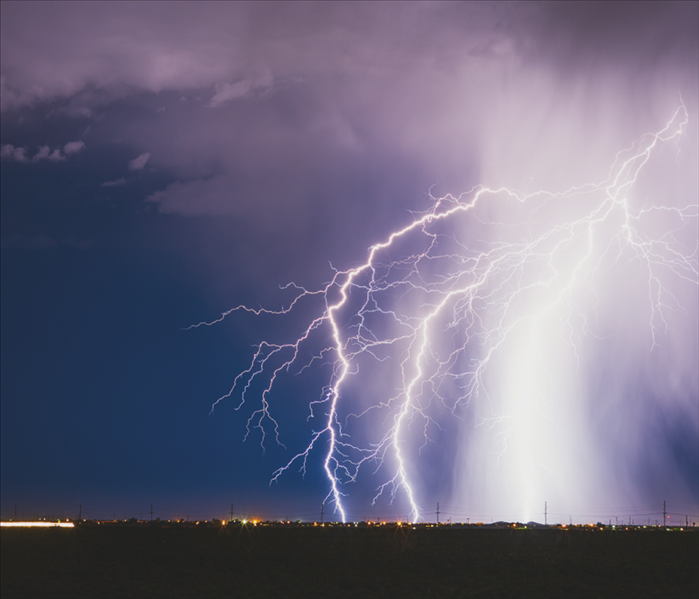 Thunderstorm in Cincinnati, OH.
Thunderstorm in Cincinnati, OH.
How Thunderstorms Can Affect Your Business
When a strong thunderstorm strikes Cincinnati, OH, there are some immediate steps you should take to protect life and property. A heavy rain storm can cause flash flooding and lightning is extremely dangerous; it can strike from miles away and hit anywhere – even inside.
The statistics for lightning hits in the U.S. are alarming:
- Around 40 fatalities per year.
- At least 9 times as many injuries.
- A high rate of permanent disabilities.
Fortunately, there are proactive steps you can take to prevent injuries and reduce property damage. In some cases, you may be expected to take reasonable precautions; for instance, if a customer is injured by high winds or other storm damage on your property, you may be liable if you’re shown to be negligent.
When Should You Begin Preparations?
Right now! Make a list of steps to take to mitigate damage to your property. Start by taking care of trees outside; dead branches should be removed and live ones should be trimmed to be at least two feet away from the building.
Now is also a great time to look at your landscaping. During a rain storm, where does the water flow? If the rain is extremely heavy, will it collect in your building? With terracing and drainage planned, you can prevent all but the most extreme storms from flooding your business.
You should also make a READY profile with your local storm damage restoration experts. This will put all the info you need in a secure cloud account so you can access it with a free app.
How About During a Thunderstorm?
There’s always a risk of lightning during convective storms. However, some really stand out for their cloud-to-ground lightning strikes. When you see lots of lightning, you should move employees and customers away from windows and access a weather report either on television, the radio or your smartphone. If severe weather or a tornado is approaching, you need to get everyone to shelter immediately.
If you’re well prepared for a big rain storm, you should have no worries about flooding. Heavy lightning storms and severe weather should be considered an emergency, so being ready to act quickly could save lives.
Water Damage Restoration Steps
1/12/2021 (Permalink)
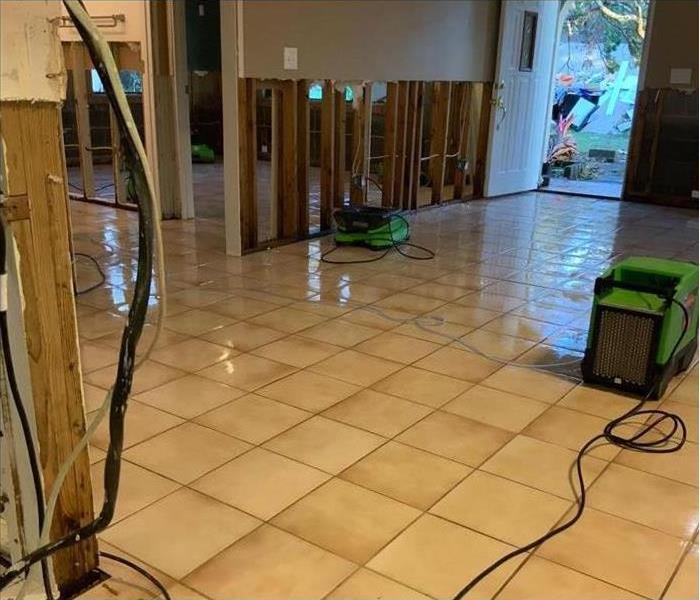 Water damage restoration in an Amberly Village, OH home
Water damage restoration in an Amberly Village, OH home
Water Damage Restoration Steps
The restoration of a home that has been damaged by water is a multi-step process that may involve the tear out of some damaged areas of the property. This guide will help you understand what to expect from the restoration process.
1. Remove Water
The first goal of the storm restoration process is to remove standing water from the home. This process should begin as soon as possible to reduce the chances of warping, structural damage and mold growth. If your home has a significant amount of standing water, you will probably need professional equipment to remove it. A water damage restoration company in Amberly Village, OH, can assist you with the water removal process.
2. Dry Out Property
Once the standing water has been removed, the property needs to be thoroughly dried to eliminate the remaining moisture. Fans and dehumidifiers may be used to remove moisture from the air and aid in drying out surfaces. Wet contents should be removed from the home and discarded or dried out before returning them. You may need to tear out sections of damaged drywall and replace them. Wet carpets should be disposed of if possible. If you can not immediately discard carpets, use an extractor or wet/dry vacuum to remove as much water as you can.
3. Clean and Sanitize
Once everything is dry, contents and surfaces should be cleaned and sanitized before repairs begin. This step will help remove mold spores and contaminants.
4. Repair and Restore
The final step of the process is repairing and restoring structural and cosmetic damage to the home. Ceilings, floors, walls and other areas may need to be repaired, painted or replaced.
Whether you need to tear out damaged drywall or completely restore large areas of your home, it is important to understand what to expect from the water damage restoration process. The earlier you begin the process, the more successful you will be at mitigating your damages.
Mitigation Versus Restoration: What's the Difference?
11/10/2020 (Permalink)
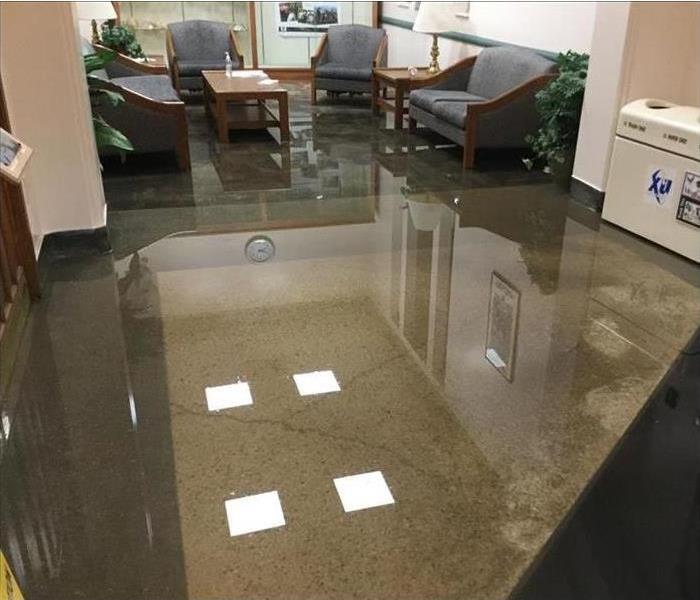 Flooded building in Cincinnati, OH
Flooded building in Cincinnati, OH
If you find your business or commercial building filled with water, you know you need to call a flood cleanup company right away – but should you call a flood mitigation crew or a restoration company? Are they the same thing? While some restoration companies also do mitigation work, mitigation and restoration are two distinct processes. Here’s what you need to know.
Flood Damage Mitigation
Mitigation is the critical first step in any cleanup effort. This process is focused on stopping the damage preventing any further loss. It involves things like:
-removing debris like tree limbs or broken glass
-covering openings in a roof, window, or wall to prevent more water from entering
-removing building contents that may be salvageable
-extracting all water from the property
-sealing off unharmed parts of the property to ensure the water doesn’t spread
-removing affected porous materials, such as drywall and flooring
-ensuring that the entire structure is dried out completely
-disinfecting the property to prevent the spread of mold and bacteria
Mitigation is usually a fairly speedy process. The more quickly mitigation is completed, the less overall damage will need to be restored. This is why mitigation is always the first goal of any flood cleanup company.
Flood Damage Restoration
Restoration cannot begin until mitigation is complete. The goal of restoration is to restore your property to its pre-flood condition. This includes things like inspecting the property, assessing the damage and removing any existing mold; repairing or replacing warped wood or flooring; cleaning and restoring the building’s contents, to the extent possible; and replacing or restoring damaged drywall and insulation. While mitigation is a relatively quick process, restoration can take a considerable amount of time, depending on the extent and nature of the damage.
Mitigation and restoration are different processes, but both are necessary after a flood. If possible, find a flood cleanup company in Cincinnati, OH, that takes care of both procedures. This will save you time in phone calls and coordinating schedules and speed up your insurance claim approval to get the work done and get you back in business sooner.
Which Items Can You Keep After a Flood?
10/19/2020 (Permalink)
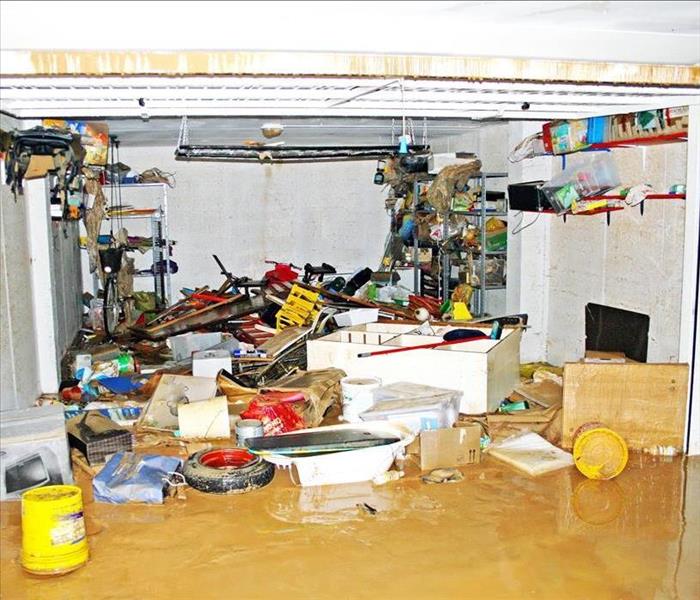 Flooded home in Amberly Village, OH
Flooded home in Amberly Village, OH
Are These Soggy Assets Okay To Use?
Once floodwater subsides, homeowners are left with the daunting task of focusing on content cleaning needs. Are these soggy assets okay to use? Are guidelines available to lead you in making upcoming decisions? Residents should carefully think about each possession, concentrating on not only the room's exposure levels but also the item's composition and personal worth.
1. Is the Water Dirty?
There are three forms of fluid contamination. Clean water, for instance, saturates but is free of microbes. A flood from a typical household pipe burst often falls into this category. Salvage many of these belongings by drying them out and wiping them with soapy water. Black and gray water, though, have high levels of bacteria; therefore, these liquids pose more of a hazard. Take extra precautions when dealing with these situations:
- Sewage breaks
- Appliance leaks
- Toilet overflows
- River and ocean flooding
If any of the above events occur, think about the answers to the next two questions.
2. Is the Object Porous?
During content cleaning endeavors, think about permeation. Nonporous things do not absorb moisture, so they can be sanitized with traditional cleaners. Porous valuables, however, act like a sponge. Bacterial and fungal spores bury deep within a substance, reproducing quickly. Even if doused with bleach, the interior of these pieces still contains undesirable organisms. Placed back in the home, unwelcome growths can spread. It's best to designate suspicious articles for permanent disposal.
3. Is It of Significant Value?
Certain items, including electronics, photos and documents, may have sentimental or financial meaning; thus, they are deemed irreplaceable. A water restoration company in Amberly Village, OH, has specialized equipment such as gamma irradiation that can kill black water germs. Simply ask the experts about the various procedures available.
As you survey the destruction, be thoughtful about your content cleaning decisions. If in doubt, don't hesitate to contact professionals who can assist you in this endeavor. Safety is a priority.
Understanding the Difference Between Mitigation and Restoration of Storm Damage
9/8/2020 (Permalink)
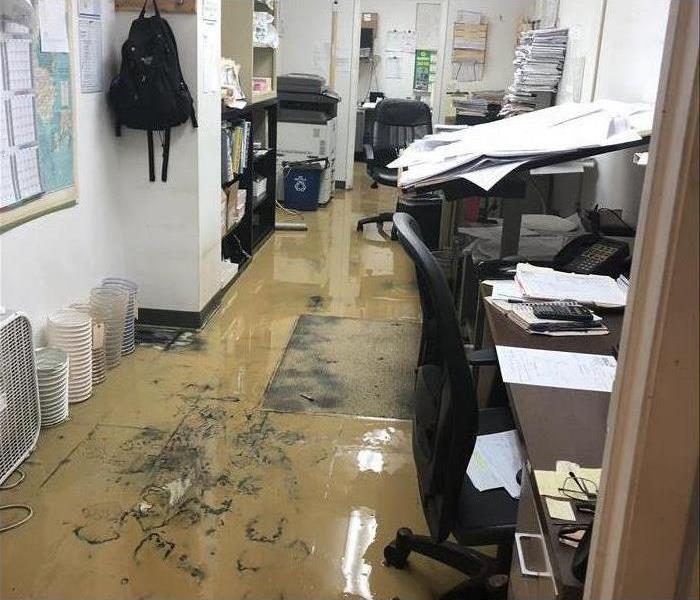 Storm damage in a Cincinnati, OH office building
Storm damage in a Cincinnati, OH office building
Mitigation And Restoration Process
Severe weather can bring with it significant concerns about your business. Many business owners fear potential flooding or wind damage and how that will affect their bottom line. Storms can play a crucial role in a companies profit-and-loss and the end of a year. Therefore, if you are concerned about the severe weather season, consider contacting a storm or flood cleanup company in Cincinnati, OH, to discuss issues related to any of several areas.
Property damage
Insurance claims
Business interruption
However, beyond the basics, it is necessary to understand some fundamental industry terms. After experiencing storm damage, you are likely to come across two specific words: mitigation and restoration. Each plays a role in how and when you restore your business.
Mitigation
A flood cleanup company often offers mitigation services to companies that have experienced recent storm damage. The purpose of these services is to prevent further damage while awaiting an inspection from an insurance representative. Typically, a mitigation company will offer board-up and tarping services. They will board over damaged windows or doors with plywood sheeting to help secure the property. They will also tarp over large holes in the roof to prevent further rain damage. Beyond the preventative steps, the company will also clean the building and remove any excess water or debris, preparing the space for the restoration.
Restoration
A restoration company specializes in the work after the initial cleanup and mitigation. The job of the restoration team is to restore the structural integrity of the building and repair any existing damage. When a restoration company finishes, your facility should look like its pre-disaster condition.
A reputable flood cleanup company may specialize in both mitigation and restoration, which is beneficial to the business. If you would like to discuss the restoration process in more detail, contact a local remediation expert. They will be happy to help and may even offer to assess your property.
Prepare Your Commercial Property For Strong Winds
3/30/2020 (Permalink)
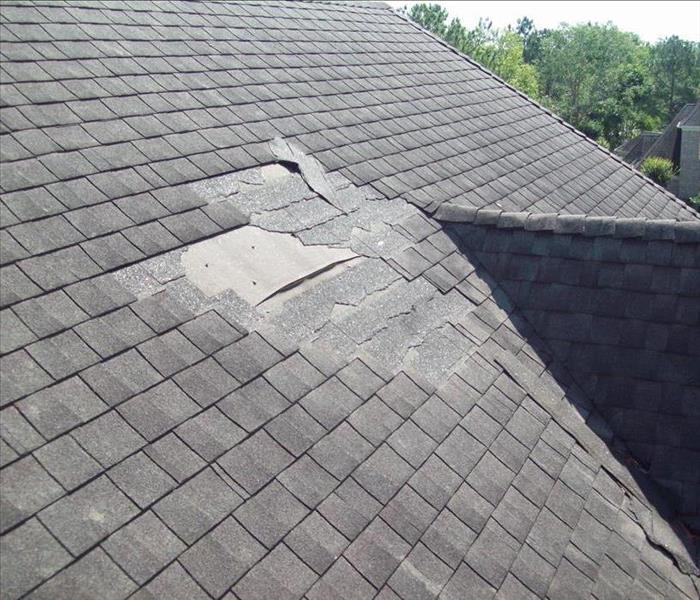 Check for missing shingles and replace as needed
Check for missing shingles and replace as needed
Storm surges can create significant damage to your commercial building in Madeira, OH. Strong winds can loosen the roof’s shingles and cause a roof leak. Tree branches can break off and crash through a window. By employing some smart proactive tips, however, you can prep your building so that the damage can be mitigated. Creating a checklist will ensure you don’t forget to inspect a critical area.
Check the Exterior Walls and Doors
To prepare for strong winds, examine the exterior walls and doors on a routine basis.
- Make sure windows and siding are firmly attached and are in good condition.
- Check exterior walls for cracks and seal any weakened areas.
- Brace overhead doors so they are secure.
Protect the Roof
A damaged roof will inevitably cause a roof leak so inspect it carefully.
- Check for missing shingles and replace as needed.
- Ensure that all other shingles are in good repair and fastened securely.
- Make sure any roof sheathing is properly nailed down.
- Check HVAC units and other machinery to ensure it is firmly attached to the roof.
- Inspect skylights to make sure they are tightly fastened and sealed to prevent leaking.
Secure Outside Equipment and Furnishings
- Outside storage sheds, dumpsters, and other equipment must be well anchored.
- Trees and bushes near the building need to be trimmed regularly.
- Outdoor furniture, grills and other equipment for employee use should be brought inside before a storm nears.
- Ensure that all outside signage on the property is secure.
- Alert employees to never park their car under a tree.
It would also be a good idea to check your commercial property insurance policy to make sure it covers wind damage. If it doesn’t, contact your agent right away.
While it’s impossible to avoid weather conditions that can create problems for your property, you can significantly reduce the risk of a roof leak or other damage by following these inspection tips.
What To Know About Flood Zones and Your Home
11/13/2019 (Permalink)
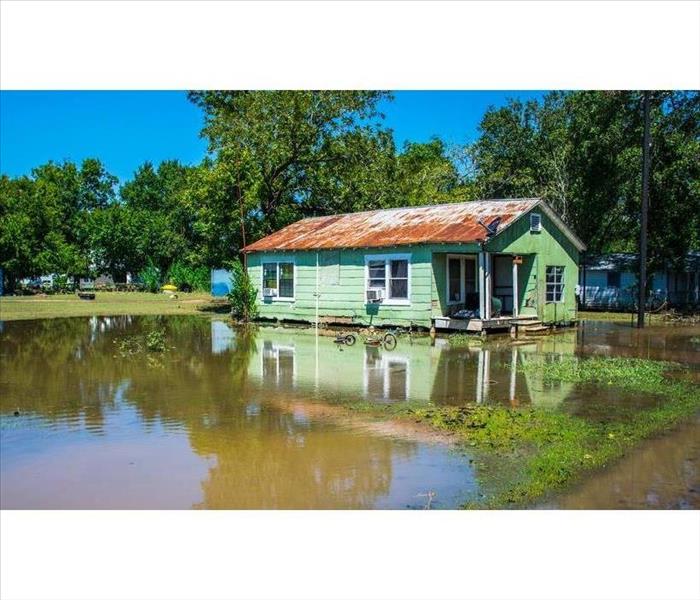 Flooded home in Amberly Village, OH
Flooded home in Amberly Village, OH
Learn How Flood Zones Can Affect Your Home
If you live in an area such as Amberly Village, OH, where your home experiences frequent storms, then you may be wondering if you’re at high flood risk. One way to know this is to determine if your home is located in a flood zone. Here are a few things you may wish to know about these zones and how they affect your home.
1. What Are Flood Zones
Flood zones are areas that exhibit geographic qualities that make them more prone to flooding. This may include being at the bottom of a watershed, coastal areas, areas near rivers, and areas that experience frequent storms. FEMA sets these risk levels and they should be marked on your local communities Flood Insurance Rate Map (FIRM), which you can look at by going to your local zoning office.
2. Is Flood Insurance Necessary
In the event your home is determined to be at risk by its position in a flood zone, you may be wondering what, if any, addition insurance will be required. The best way to determine this is to talk to your insurance agent about what’s included in your existing plan, and if any supplemental plans are available for additional coverage. It’s important to note than in many cases flood insurance is considered to be a separate policy.
3. How to Deal with a Flood in the Home
If a storm does cause flooding in your home then it's best to contact a flood damage restoration service as quickly as possible. These professionals have the tools necessary to move large quantities of water, and can also make any repairs your home may need. The restoration team can also check for any additional problems flood water may cause, such as potential mold growth.
As explained earlier flood zones are areas that exhibit geographic qualities that make them more prone to a flood. It’s important to note that in some cases having a home inside a flood zone can affect your flood insurance coverage. If your home does experience flooding it's best to contact a professional as quickly as possible for any repairs.
How To Mitigate Storm Damage to Your Property
10/24/2019 (Permalink)
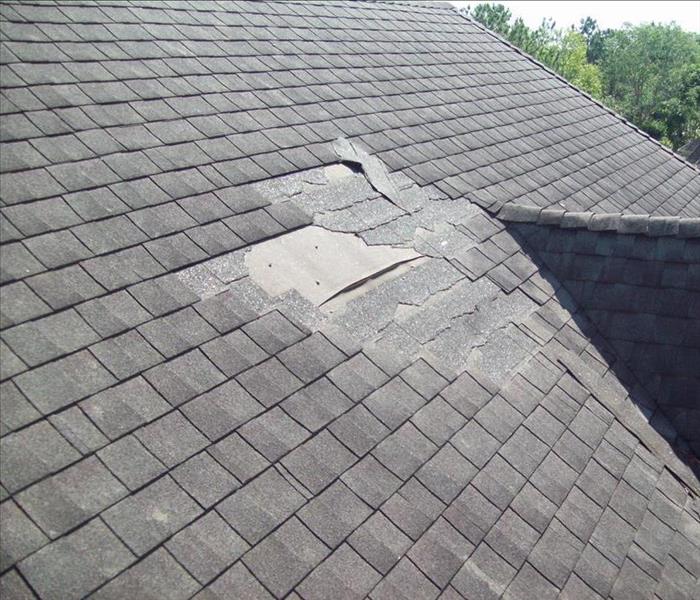 Missing roof shingles in Mariemount, OH
Missing roof shingles in Mariemount, OH
How To Mitigate Storm Damage to Your Property
The best way to prevent storm damage is to prepare before the winds and rain hit Mariemount, OH. Prevent damages, such as missing shingles, a roof leak, broken furnishings, and other havoc by taking specific steps as soon as you know there's a storm on the way:
- Trim trees and shrubs around your business to prevent branches from breaking winds or becoming projectiles.
- Pack up furnishings outside your building and stash any decorations or marketing signs that aren't completely attached.
- Board up the windows. Again, the best time to gather these supplies is before there's any news of a storm. Purchase the hardware you'll need and store it safely until you need to use it.
- Reinforce any garage doors. These doors tend to be relatively flimsy. The damage to the doors or to your exposed inventory or vehicles could become very expensive.
Of course, proper maintenance is an essential step in protecting your company property.
Gather Evidence of the Damages
Before you take any cleanup steps and before you contact professionals to take care of the work, record the damage. First, take photos of all damage to document your losses for the insurance company. Make a written inventory of all commercial and personal property that was damaged. Don't forget to hold onto receipts when work is completed.
Practice Preventative First Aid
After the storm has passed, there are several steps you can take to keep your commercial property safe, avoid that annoying roof leak, and keep your repair costs down. One of the first is to address any damage to the roof. Use tarps and plywood to board up holes in the roof, cover holes in windows and skylights, and inspect the rest of the property.
Turn Major Repairs Over to Professionals
You may find that siding has been blown off the building or a tree branch has broken the building or some property directly. In many cases, a storm damage repair and cleanup professional is the best person to repair your damaged roof. There are many safety concerns to keep in mind before sending an employee to the top of your building. There's no roof leak more important than a person's safety.
How To Handle a Sewer Backup in Your Bathtub
9/11/2019 (Permalink)
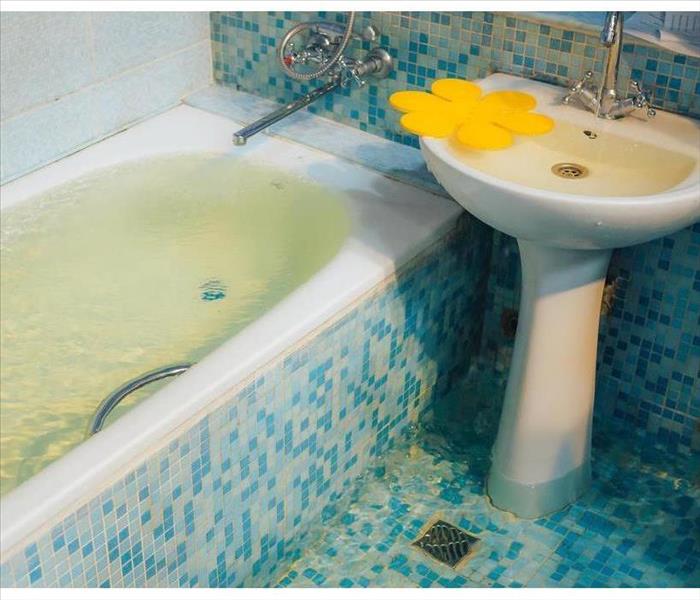 Sewer backup in a Mariemount, OH bathroom
Sewer backup in a Mariemount, OH bathroom
How To Handle a Sewer Backup in Your Bathtub
There’s no denying that a sewer backup leads to a lot of unwanted and aggravating issues, including the less-expected issue of a bathtub backup. Whether the backup you’re dealing with is from a city sewer line clog or flooding from a septic system overflow, it must be dealt with in a timely manner.
When assessing damage to your property in Mariemount, OH, there are steps you can take yourself and there are steps that likely require specialists. Here are some tips to get you started:
- Remove children and pets from the affected area immediately.
- Stay safe – wear protective gear and turn off utilities before dealing with the sewer backup.
- Remove contaminated items and sanitize what you can.
- Know when you need an expert – many plumbing issues are advanced and require professional remediation.
Why Is There Sewage in the Bathtub?
Bathtub backups may not be as frequent as other flooding issues, but they are often just as serious. This issue occurs when clogs in your main sewer lines are so severe that the water is forced elsewhere – as in back into your home rather than away from your home.
What Does This Mean?
Wastewater in your bathtub is clearly not a good sign, as you know. If there is sewage in your tub, then the drains and sewer lines are not allowing water to flow away from your property. This means there is a large clog somewhere in the system, and thus the water is redirected into unwanted areas.
What Can You Do?
First, remove kids and pets from contaminated areas. You also must be sure to protect yourself before sterilizing the area. Then, remove porous items – towels, rugs, curtains, etc. – to prevent cross-contamination. To ensure that the hazard has been appropriately contained and future issues won’t arise, you should consult professional water damage repair services.
If you’ve experienced this issue in your Mariemount, OH, home, don’t delay in addressing the sewer backup. Take bathtub backup seriously, as it can be an indicator of bigger plumbing problems – but also don’t panic, as there are experts at the ready to help make your house your home again.
5 Commercial Building Areas to Inspect While Preparing for a Storm
8/14/2019 (Permalink)
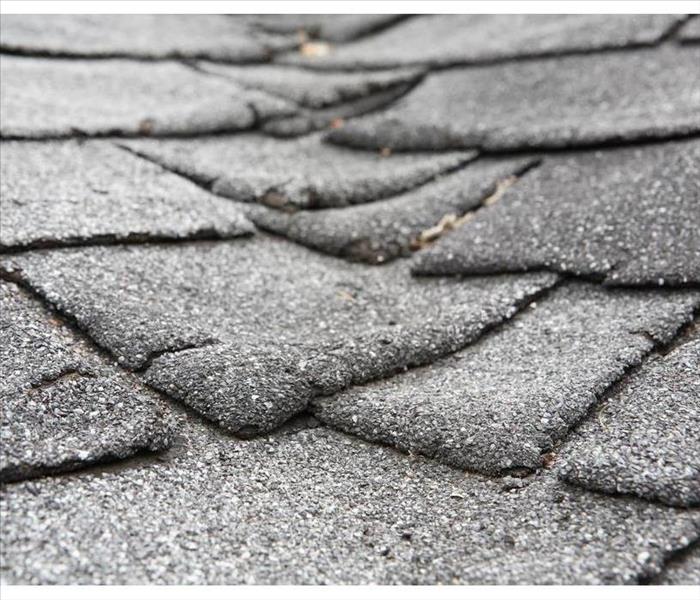 Cracks on roof
Cracks on roof
Building Inspection When Preparing For A Storm
When you are preparing for a storm in Indian Hill, OH, it is important to perform a building inspection on the exterior as well as the interior. Doing this will allow you to find any areas of concern that could contribute to damage to the property. Be sure to check the following areas thoroughly.
1. Walls
Perhaps the most obvious area to inspect is the walls. These can have cracks or weak sections that might let water inside. Performing exterior maintenance to fix these problems can prevent weakened structure and the spread of mold.
2. Doors and Windows
The areas around your doors and windows can sometimes deteriorate more quickly than others. Because of this, you should check them carefully. Make sure that they are sealing properly and won’t let water inside.
3. Roofing
During the building inspection, it is important to check the roof as well. Damage here can result in leaks that can cause water damage inside the building. Ensure that there are no cracks, missing shingles or debris.
4. Gutters and Drains
Exterior maintenance should not be entirely contained to the building itself. The drains and gutters connected to it should be looked at as well. If these are not cleaned out, they can cause water to back up and enter the walls and ceiling.
5. The Surrounding Area
While you may be more concerned keeping the building maintained, do not overlook the rest of the property. If there are objects and debris in the yard, these can be picked up by the wind and thrown against the building. This can damage the walls and roof and may even result in shattered windows. Trim any nearby trees as well.
It is important to do exterior maintenance if you are expecting a storm, but this is not the only time it should be done. Have a professional perform inspections and needed repairs regularly to keep your building in top shape. If there is damage after severe weather, an emergency restoration company can restore it to its previous condition.
Tips for Removing Foul Odors After a Flood
7/12/2019 (Permalink)
 Flooded home in Cincinnati, OH
Flooded home in Cincinnati, OH
Tips for Removing Foul Odors After a Flood
The water damage that occurs when your home floods in Cincinnati, OH, often comes with odors and mold growth that continue to permeate your residence long after the water has subsided. You can take care to eliminate odors and preserve the safety of your dwelling with the following measures:
1. Air Things Out
Open all doors and windows to allow air to circulate in your residence. This should help dissipate any lingering smells that remain and will also facilitate drying of the affected areas.
2. Dry the Wet Areas
You may install dehumidifiers to speed up the drying process. Removing moisture from porous and absorbent surfaces such as carpet and upholstery can greatly reduce the chance of foul aromas remaining after the flood and can mitigate the appearance of mold.
3. Deodorize Your Home
There are natural and inexpensive methods that you can utilize to expedite the deodorizing process in your house. Baking soda sprinkled into carpets and other absorbent surfaces then vacuumed up can help greatly with getting rid of foul odors. On less porous surfaces, vinegar applied liberally can aid in combating persistent smells.
4. Keep an Eye Out for Mold
As with any area that has had prolonged exposure to moisture, mold growth can be a threat that, if not addressed immediately, poses a potentially recurrent problem that can present itself throughout the life span of your residence. It is imperative that proper steps are taken to ensure that mold and spores do not have the opportunity to spread in your home.
5. Be Aware of Contaminants
Sewage loss can lead to your home being contaminated by sewage contents when flood water finds its way past your threshold. This can leave behind an overpowering smell even after the moisture has been removed due to the bacteria in the water. These smells often cannot be removed by household cleaners and require the services of a professional flood restoration company.
Mold growth and lingering odors are just two of the issues you may have to contend with after a flood. Fortunately, with experienced mold remediation specialists, you don't have to go it alone.
Commercial Storm Preparation
5/6/2019 (Permalink)
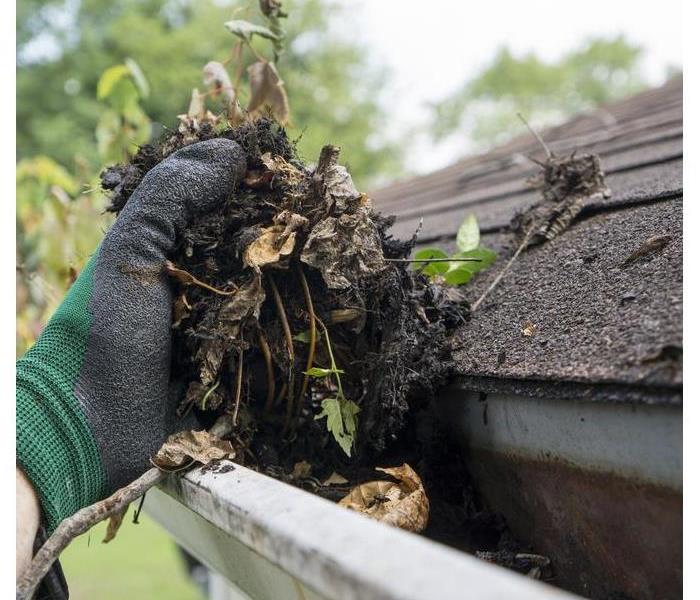 Keeping your gutters clean will help keep water from backing up under shingles and into your building
Keeping your gutters clean will help keep water from backing up under shingles and into your building
How to Protect Your Assets and Employees in The Event of a Flood Damage
Many business owners in Indian Hill, OH, are inadequately prepared for a major rain storm event. Do you know how to protect your assets and employees in the event of a serious flood damage situation?
1. Site Assessment
One of the simplest things you can do to prepare your company for severe weather is to inspect the site. Ensure that the foundation has no major points of fluid entry and that the roof and gutters direct rainfall away from the base of all buildings. Trim any trees with dead branches, as these can become an airborne hazard during high winds. Most larger buildings will need a lightning rod, which must be maintained and properly grounded. If your site has windows that require storm shutters, draw them at the first sign of trouble.
2. Training and Readiness
Don't forget the human element. Since your employees are your most valuable asset, you must supply your workforce with sufficient information about how to respond to a severe rain storm. For tornadoes, designate an interior hallway on the ground floor as a temporary shelter. For hurricanes and other long-term hazards, ensure that your staff comply with local evacuation orders and other pertinent ordinances. If you keep normal working hours during a potential weather event, stay aware of outdoor conditions through a NOAA radio broadcast or website.
3. Other Considerations
Your insurer can assist you with a business continuance plan should a thunderstorm make normal operations impossible. Retain paper copies and digital backups of all policies, records, and tax information. If you anticipate filing a claim, contact your adjuster as soon as possible. You will also likely need a qualified professional service to help with flood cleanup.
You can't prevent a rain storm, but you can keep it from disrupting day to day activities at your workplace. Safeguard your employees and your inventory by preparing for every type of severe weather.
Landscaping and Water Damage
4/25/2019 (Permalink)
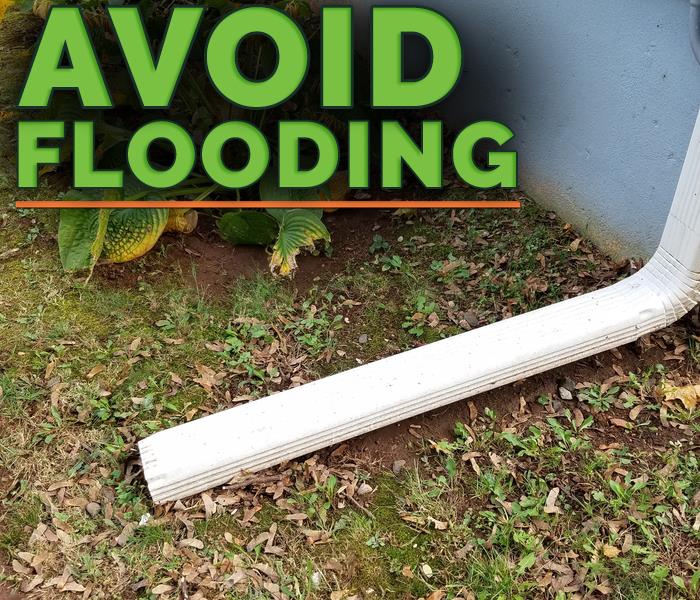 Most homes constructed according to typical building codes will have correctly sloped roofs and gutters that divert rainwater away from the house.
Most homes constructed according to typical building codes will have correctly sloped roofs and gutters that divert rainwater away from the house.
Many homeowners in Cincinnati, OH are unaware of the relationship between problematic landscaping practices and flood water entering the home. Protect yourself against unnecessary basement or outside flooding by implementing a few simple yard management strategies.
1. Roofing and Gutters
Most homes constructed according to typical building codes will have correctly sloped roofs and gutters that divert rainwater away from the house. However, if the slope and porosity of the soil immediately surrounding your house are causing issues, it may be beneficial to extend the reach of your gutter downspouts with some inexpensive attachments. These flexible hoses will deposit the water farther into your hard, which can prevent water from pooling around your foundation during a rain storm.
2. Ditches
For some yards, simply redirecting the gutters may not be enough. Outside flooding problems from other properties may cause unintended water flow to your residence. In these cases, extra landscaping design may be required. A drainage ditch with a large perforated PVC pipe at the bottom can solve a number of flooding issues and divert unwanted water into the storm drain. Such a solution provides immediate results and can be implemented by any homeowner with a few inexpensive materials from a local hardware store.
3. Mulch
Another tip for the homeowner wanting to improve rain drainage involves the type of ground cover. Short grasses in silt or clay soils tend to provide little protection against erosion. Over time, these materials will dissolve in rain water and flow away from the property, exacerbating flooding problems. Using gravel or heavy mulches can improve drainage in problem areas that naturally get exposed to heavy rainfall, while preventing the soil beneath from washing away.
While the above tips can reduce the risk of interior and outside flooding, they are not a replacement for a qualified flood restoration service in the event that a significant amount of water enters your home.
Workplace Emergencies: Preparing an Evacuation Route
2/11/2019 (Permalink)
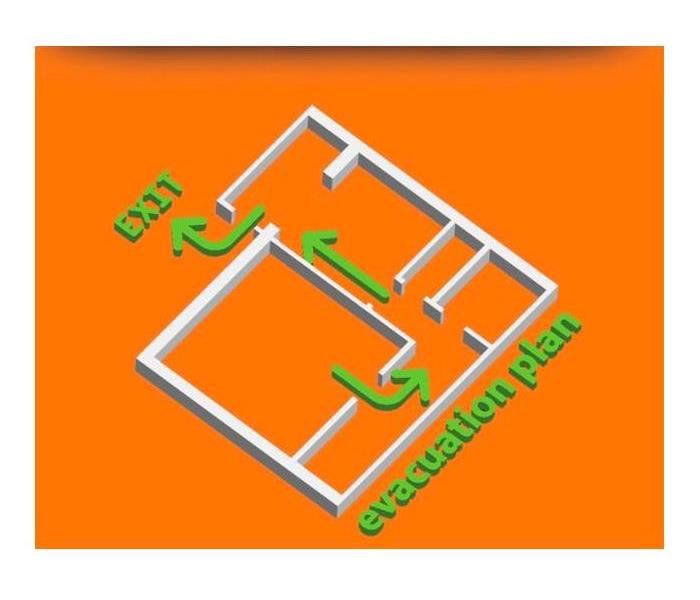 Every employer is required by federal regulations to develop and provide adequate evacuation plans to their employees.
Every employer is required by federal regulations to develop and provide adequate evacuation plans to their employees.
Preparing An Evacuation Route
While everyone, including business owners, has had to go through at least one fire drill in their lives, it is different when you have to design one. Business owners are required by law to have designated exit routes for their employees, and they are supposed to practice these routes to help employees prepare for an emergency. Therefore, in developing and designing your emergency exits, it is important to keep a few traits of a good plan in the forefront of your mind.
1. Ensure Proper Lighting
Every exit should be well-lit and designated. You can mount light-up exit signs throughout your property that can help guide employees and clients safely outside. Also, you can install battery powered lighting that is triggered in the event of an outage, ensuring that everyone can see where they are going.
2. Find Exits With Appropriate Space
A fire drill is an excellent way to determine if all your planning has paid off. Your employees should have no problem working their way toward an exit. If you notice that there is too much congestion because a hallway is too narrow or there are obstacles in the way, then you will have to change the route or clear the obstructions.
3. Place Drawings Throughout the Facility
Beyond practicing escape routes, you should place evacuation maps throughout your building. These maps can be placed near fire extinguishers and other high-traffic areas to ensure they are easily spotted.
4. Seek Guidance and Feedback
It never hurts to ask for help. If you are unsure of the best way to design evacuation routes, you can reach out to your local fire department or a fire remediation specialist in the Cincinnati, OH area for guidance and feedback on your plan.
Every employer is required by federal regulations to develop and provide adequate evacuation plans to their employees. Also, it is suggested that businesses conduct at least one fire drill annually to ensure employees are familiar with those routes.
When Storms or Floods hit Cincinnati, SERVPRO is ready!
9/21/2018 (Permalink)
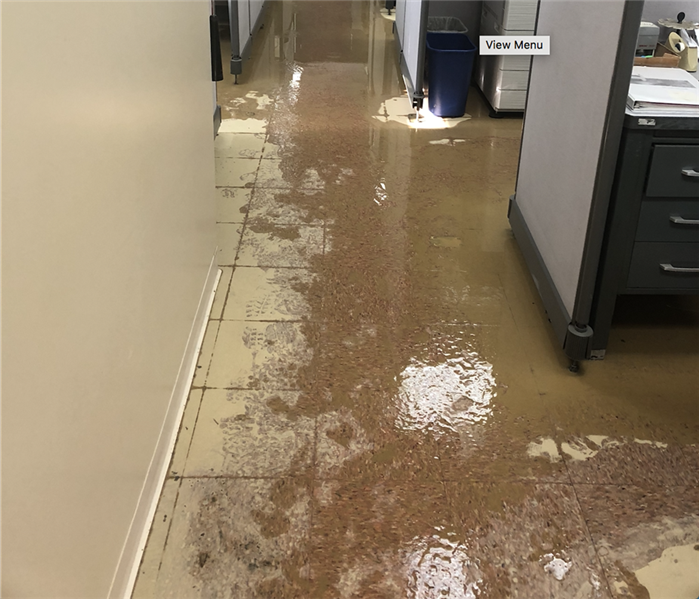 Storm Damage left behind dirt and water in a Cincinnati Commercial Office Building
Storm Damage left behind dirt and water in a Cincinnati Commercial Office Building
SERVPRO of East Central Cincinnati specializes in storm and flood damage restoration. Our crews are highly trained and we use specialized equipment to restore your property to its pre-storm condition.
Faster Response
Since we are locally owned and operated, we are able to respond quicker with the right resources, which is extremely important. A fast response lessens the damage, limits further damage, and reduces the restoration cost.
Resources to Handle Floods and Storms
When storms hit Cincinnati, we can scale our resources to handle a large storm or flooding disaster. We can access equipment and personnel from a network of 1,650 Franchises across the country and elite Disaster Recovery Teams that are strategically located throughout the United States.
Have Storm or Flood Damage? Call Us Today 513-561-7378
Cleaning Tiny Shards of Glass
9/21/2018 (Permalink)
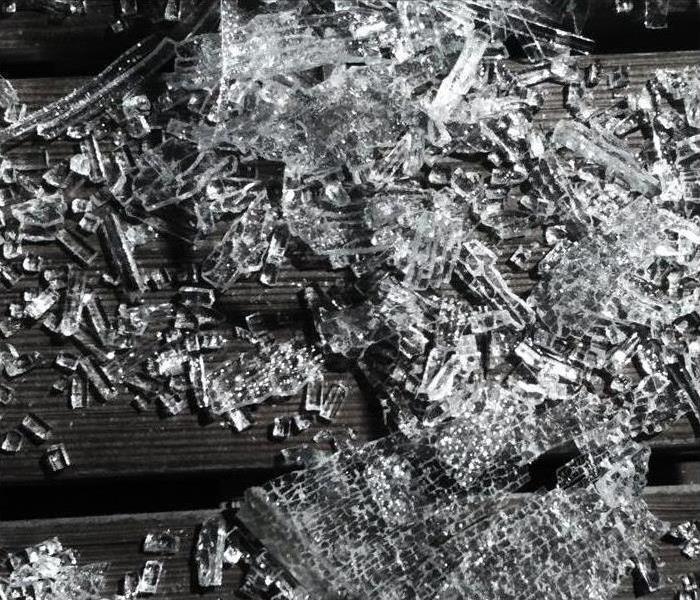 Shards of glass stuck in carpet.
Shards of glass stuck in carpet.
Cleaning up tiny shards of broken glass can be a pain. Storms and high winds can cause windows to break which should be boarded up to keep out the elements.
But what do I do with the broken glass?
Try using modeling clay it can be an easy way to pick up the small pieces that your broom or vacuum might have missed.
We are often times challanged with a less than standard cleaning projects. One of our very first customers, who has used us on multiple occasions, used us for glass clean up and board up services. The aforementioned customer has a large curio cabinet which suffered a serious shelve malfunction resulting in a lot of broken glass and a serious cleanup effort. We had a crew of three onsite cleaning the broken glass out of the carpet. Our crew worked for about three hours to get the glass removed.
No job is to big or to small for SERVPRO of East Central Cincinnati give us a call at 513-561-7378.
3 Common Ways That Powerful Storms Can Damage Your Solar Panels
9/18/2018 (Permalink)
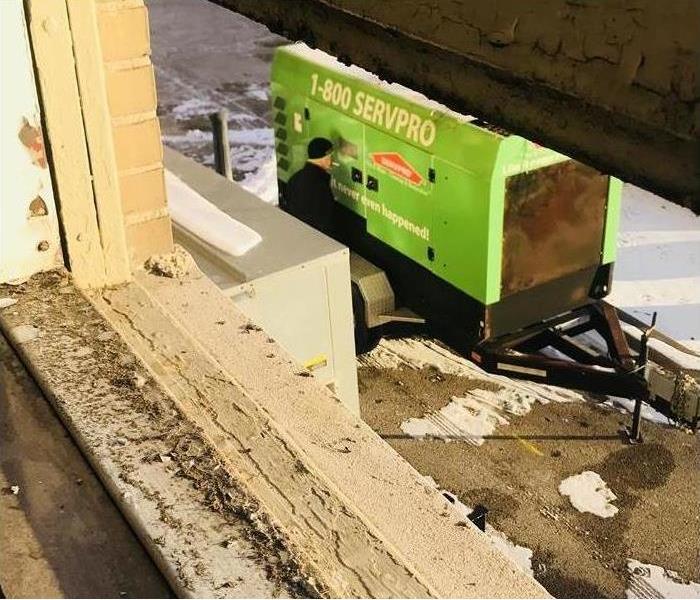 Power generator after a storm on a commercial project in Indian Hill, OH
Power generator after a storm on a commercial project in Indian Hill, OH
3 Common Ways That Powerful Storms Can Damage Your Solar Panels
Once a major storm passes through Indian Hill, OH, every home in the neighborhood can show you its destructive power. However, if you’re curious about buying solar panels for your residence, knowing what kind of significant roof damage or panel destruction can be caused by brutal storms is of the utmost importance. Here are three general causes of solar panel damage, often inflicted by the intensity of Mother Nature’s outbursts.
1. Water damage due to insufficient sealants can force panels to fail. Given that panel seals aren’t vastly different from those of window panes, having outdated or cracking seals that allow water to seep through can create the beginnings of substantial panel damage. Degradation and short-circuiting can begin to appear as a result of this wet intrusion. Therefore, resealing panels on a regular basis is a crucial part of being a panel owner.
2. Intense hail storms can lead to faulty or destroyed panel faces. The onslaught of destructive hail on solar panels can wreak havoc on the surface of the glass, or simply break the panel altogether. If a powerful hail storm is expected, taking precautions by covering panels can help. However, unexpected hail storms can leave a panel owner frustrated, as there are not many options for preventing hail damage.
3. Falling debris can not only create significant roof damage but damage to panels, as well. If a strong storm passes through your town, any resulting debris such as broken tree branches, falling rocks or mud, etc. can become a serious hazard to panel glass. Even the simplest leaves and twigs can create micro-scratches on the panel surface. A good rule of thumb is to keep solar glass in open areas and out from under large trees, if possible.
When you live in a place like Indian Hill, OH, owning solar panels can be a great investment. However, panel damage due to intense storms is always a possibility. Therefore, these three common causes of panel destruction should often be considered before making a final decision for your home.
Help for Homeowners Without Flood Insurance
7/23/2018 (Permalink)
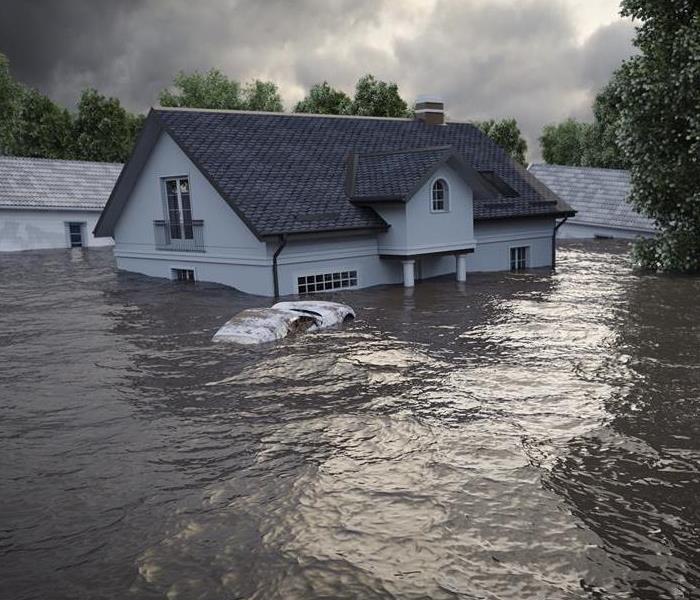 If you live in a floodplain in Cincinnati, OH, ask your agent about flood insurance.
If you live in a floodplain in Cincinnati, OH, ask your agent about flood insurance.
The bad news is that your house has flooded in Cincinnati, OH. The worse news is that you do not have flood insurance. Fortunately, there is good news. The Federal Emergency Management Agency (FEMA) coordinates federal support for those involved in a disaster. Learn if you are eligible for assistance and how to take the next steps.
Eligibility Requirements
Homeowners or renters must fit all criteria below in order to apply for FEMA assistance. Review the following to see if you qualify:
• A major disaster is federally declared for your state and county.
• The declared disaster caused damage to your home, personal property or vehicle.
• A member of your household is a US citizen, qualified alien or non-citizen national.
• You are not applying to duplicate homeowner’s or flood insurance coverage. You must provide proof of insurance benefits.
How To Apply for Assistance
If you meet the eligibility requirements, take these next steps:
• Go to https://www.disasterassistance.gov to complete the application.
• An inspector then calls you to set an appointment to survey the damage.
• If you receive grant money, it does not have to be repaid. However, the money is supplemental in nature and not designed to cover the complete restoration of your property. Rather, it helps you repair your home to a safe, livable condition.
• In addition, to grant money, you can apply for a disaster loan that needs to be repaid. This allows you to return your home and belongings to preloss condition with the help of a restoration specialist.
If you live in a floodplain in Cincinnati, OH, ask your agent about flood insurance. However, whether or not you have this specialized insurance policy, there may be FEMA assistance available to you in the event of a major disaster. If a federal disaster is declared in your county, confirm your eligibility status and follow the above steps to repair or restore your home and personal property. For more information, visit http://www.SERVPROeastcentralcincinnati.com/.
Summer Storm Tips: 3 Ways To Keep Your Business Safe
6/13/2018 (Permalink)
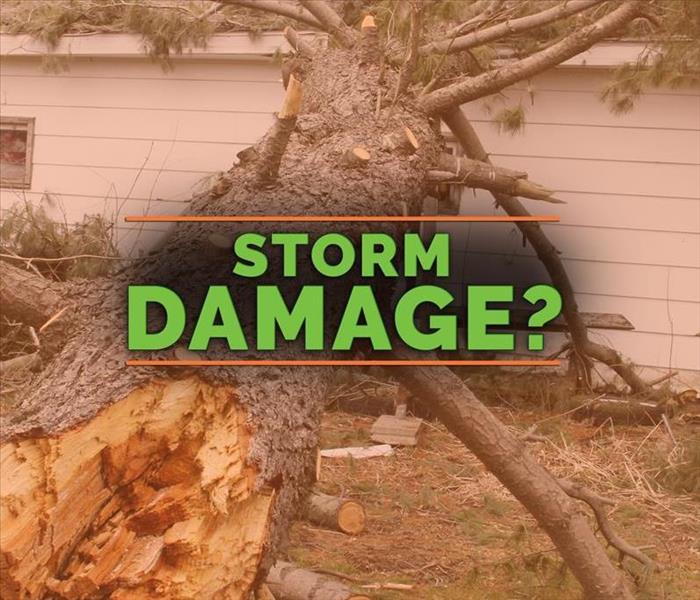 Strong winds, a sudden rainstorm and lightning can all threaten your Cincinnati, OH, business.
Strong winds, a sudden rainstorm and lightning can all threaten your Cincinnati, OH, business.
When powerful summer storms move through Cincinnati, OH, you may be concerned about the impact they might have on your business. From a torrential rain storm that could cause flooding to howling winds and flying debris, there are many potential dangers these storms might produce. However, there are a few actions you can take to guard your commercial building against summer storms and protect your investment.
1. Maintain Your Landscaping
Keeping your landscaping trimmed may reduce the risk of roofing and window damage during a storm. When long branches are whipped around by high winds, they might shatter window glass and cause injury to anyone standing nearby. Contract a landscaping company to maintain your trees and shrubbery all season long to protect them and your building.
2. Teach Your Employees Storm Safety
While thunderstorms are fascinating, they can also be dangerous. Lightning and strong winds could pose a threat to your employees, so it is wise to teach them about how to stay safe during a weather event. Ask that they stay clear of windows and skylights during a thunderstorm and turn off or unplug all electronic devices in their area. Post a list of emergency phone numbers, including that of your local water department, electric company and a storm damage and restoration service at each station so employees can call for help when necessary.
3. Invest in a Lightning Rod
If your building has more than three stories, you may want to have it fitted with a lightning rod. This can protect your business from electrical surges that may occur during a direct lightning strike. Any type of rain storm is capable of producing lightning, which can cause fires as well as destroy your building’s power system. A lightning rod diverts a strike away from your building, eliminating these dangers during powerful storms.
Strong winds, a sudden rain storm and lightning can all threaten your Cincinnati, OH, business. However, when you are well prepared and know how to keep your employees and property safe, you have a better chance of weathering any storm that comes your way. For more information, visit http://www.SERVPROeastcentralcincinnati.com/.
Roof Repairs
12/10/2017 (Permalink)
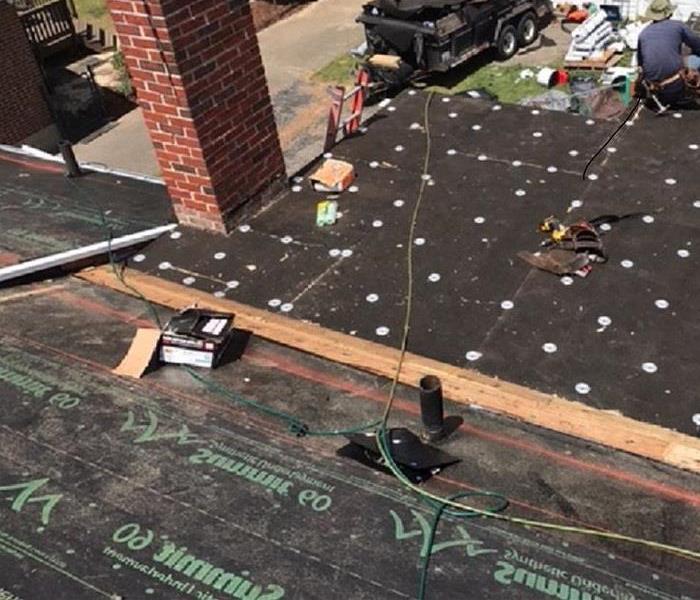 Custom flat roof repairs
Custom flat roof repairs
SERVPRO of East Central Cincinnati is a full service provider meaning we not only mitigate your damage we help make it "Like it never even happened."
The construction services side of our franchise has developed a long list of satisfied customers. We are happy to handle the smallest repairs and experienced enough to perform custom home building services as well as commercial projects.
The project shown in this picture is a flat rubber membrane roof system that ties into an existing shingle style roof installed at a local property here in Cincinnati. This home suffered from a tree that fell on the addition and caused interior and exterior damages. SERVPRO of East Central Cincinnati was able to put the property in pre loss condition in under 30 days. Call us for all you home needs 513-561-7378






 24/7 Emergency Service
24/7 Emergency Service


























